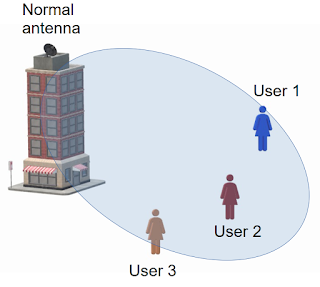5G Wireless Part II: Blurred lines
Let's begin where we left off in Part I. Could 4G keep up with the changing times? Yes. For a while, operators continued scaling up their infrastructure. Then they hit a goldmine of technology called MassiveMIMO (pronounced massive-my-mo).
Traditionally, the cell-towers have one antenna focusing on an area. If you draw the coverage of the antenna, it looks like a big balloon.
The problem is, at any given time, the tower can only transmit to one user. For example, when the tower transmits to User 1, that data is meaningless for User 2 and User 3. User 2 and 3 will have to wait for their turn to get their data. This happens very fast, in a matter of milliseconds, for us to notice.
The problem is, at any given time, the tower can only transmit to one user. For example, when the tower transmits to User 1, that data is meaningless for User 2 and User 3. User 2 and 3 will have to wait for their turn to get their data. This happens very fast, in a matter of milliseconds, for us to notice.
In MassiveMIMO, the tower has multiple antennas. The signal at each antenna is modified slightly to make the coverage not balloon-shaped but narrower, pencil shaped. Now, we can modify the signal of each user separately, add it all together and then transmit, and it looks like three beams pointing at each user.
What does this mean? We can transmit meaningful data to multiple users simultaneously. Or in other words, we can support more users. This technique has a self-explanatory name, Beamforming.
Similar technique can be used in the phones to get better reception. In fact, high-end phones from Apple and Samsung have up to 4 antennas to do just that. This upgrade to 4G is recent and is still being rolled out all over the world. Most likely, instead of calling it LTE-Advanced-Plus-Max-Pro-blah, some operators will just call it 5G.
But 5G is more than that. Beamforming solves the issue of supporting more users, but how to get even higher data rates? One option is to fine-tune the OFDM technology but it will not give significant increase in data rates. Let's call it Basic 5G. The other option is to use radio waves of higher frequency. This is called millimeter-wave 5G.
The problem with higher frequencies is that the loss of signal is very high. A Basic 5G cell-tower has a range of 1-2 km. But the millimeter-wave tower will have a range of only 50 m. That means, for normal coverage, operators have to build a large number of such small cells. Also, towers and phones will need new hardware to use higher-frequencies. So operators are now saying, "we will upgrade our 4G networks, eventually we will switch to Basic 5G and continue slowly building the infrastructure for millimeter-wave 5G".
In the future, how 5G is marketed will be confusing. For example, in USA, Verizon and T-Mobile both advertise their 5G networks, but Verizon uses millimeter-wave while T-Mobile uses Basic 5G. Last year, AT&T pushed a software update to their phones and started calling it 5G Evolution (they were heavily criticized for misleading consumers).
That's where we are right now. You might ask: do we really need 5G? All I can say is, our needs find a way to up themselves and it is the job of any technology to be one-step ahead. Take for instance the forced isolation due to Coronavirus. This will likely bring innovation in virtual reality (think 360 degree videos, virtual meetings, immersive gaming). Once people get used to such applications, they will also want them on-the-go. When that day comes, 5G will be ready.




Comments
Post a Comment